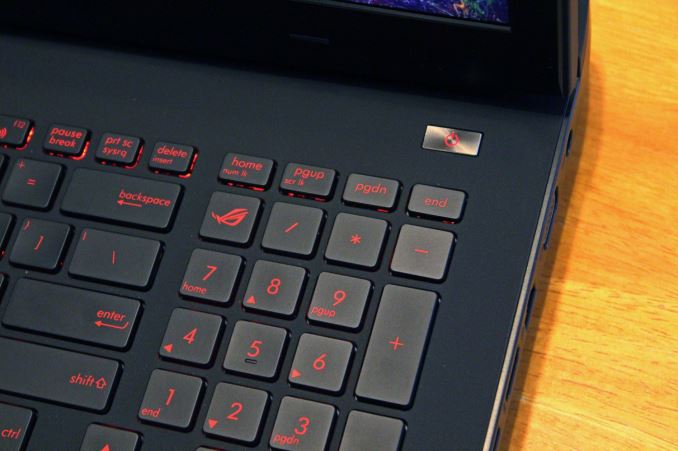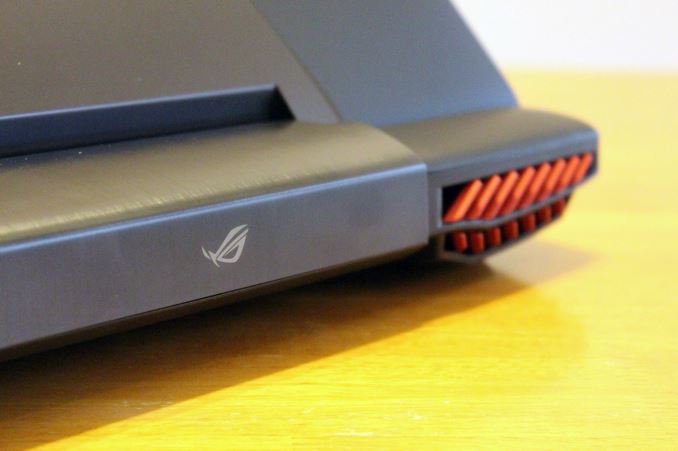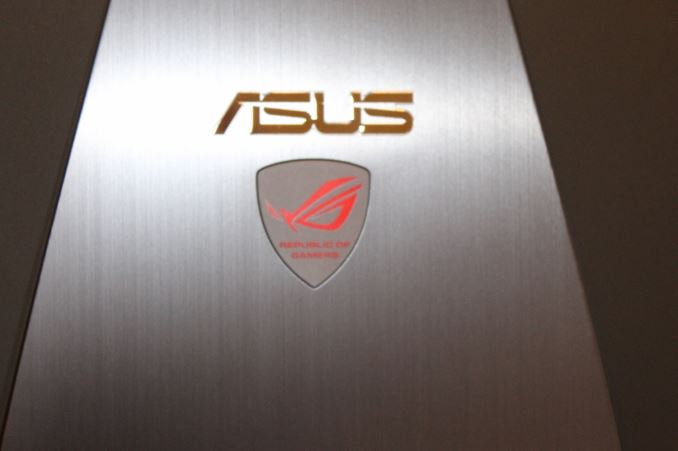The ASUS Republic of Gamers G751 Review: G-SYNC Comes To The Notebook Computer
by Brett Howse on July 29, 2015 8:30 AM ESTFinal Words
Evaluating the ASUS G751 is my first opportunity to use G-SYNC when gaming, and to that end G-SYNC has certainly lived up to its billing. Some of that would also be the very powerful hardware that ASUS has packed into the G751. The GTX 980M continues to impress, and in a device of this size, cooling is not an issue. The other part of the smoothness when gaming though is ASUS’s decision to include a 75 Hz IPS panel. The combination of G-SYNC with this panel makes practically any gaming scenario a silky smooth experience.
The package has some hits and misses. The keyboard and trackpad are quite good, and I’ve already praised the IPS panel which in addition to the 75 Hz refresh rate, has decent color accuracy and contrast. It’s a big step up from the TN panels which can still be found in some gaming notebooks. ASUS has also included plenty of connections including four USB 3.0 ports and a network port. On the miss side is, at least in my opinion, the styling. The G751 seems to have been styled against gaming laptops from a couple of years ago, and hasn’t moved to a sleeker form factor with more premium materials than plastic. Some of that may have been costs though, since ASUS is trying to offer a powerful system at a better price.
The thicker form factor and massive weight of this notebook certainly reduce its portability, and that is further hampered by the poor battery life, which is dragged down by the lack of Optimus support. But for the target audience this is going to likely be the least important criticism. The benefit of no Optimus is G-SYNC support, which on a device like this is certainly the right trade-off.
At this point, all of the hardware inside of the G751 is pretty well known, but that doesn’t take back what it does. The Core i7-4720HQ processor is plenty powerful for most tasks, and while it would have been nice to see ASUS upgrade it to the Broadwell parts, it’s hard to fault them since the quad-core Broadwell upgrade was pretty late in coming. The NVIDIA GTX 980M is the star of the show, as it tends to be, offering some pretty impressive gaming performance in a portable notebook. ASUS has also outfitted the G751 with 24 GB of memory in this model, and they offer an upgrade with 32 GB as well. The included storage is very fast, and it’s great to see them make the move to PCIe based storage. The XP941 is a very quick drive and storage speeds should not ever be an issue. For those that need more flash storage, ASUS does offer a 512 GB version as well as the 256 GB model sampled. The days of the optical drive seem to be numbered, but it’s handy to have a Blu-Ray burner available, and I’ve already used it a few times.
One of the strongest features of the G751 is the cooling system, which seems to pretty easily handle the heat output of the CPU and GPU, but it does this while maintaining a relatively quiet sound levels. It really is quite amazing to be gaming on a system this powerful, and while you can hear the fans, the output and frequency are both low enough to not really bother you. Most gaming laptops are almost always going to need headphones, but the G751 is certainly the quietest gaming notebook that I have encountered.
Overall, I’ve really enjoyed my time with the ASUS G751. It offers plenty of power, a good display, and is among the first laptops to offer the supurb game smoothing capabilities of G-SYNC. It is certainly not inexpensive at $2150 as tested, to $2650 (MSRP) with a faster CPU and double the SSD storage, but it comes in at a good price for a system with this much performance. Online, you can find the as-tested model for $1900 at Amazon, which is a good chunk of change less than the MSRP and really adds to the value of this offering. To me, the one real downside is the styling, but that’s one thing that is really up to the individual. The combination of G-SYNC, a 75 Hz IPS panel, and the GTX 980M make this an incredibly potent gaming notebook.













52 Comments
View All Comments
meacupla - Wednesday, July 29, 2015 - link
Correct me if I'm wrong, but didn't optimus cause a ton of problems that people just wanted to disable it permanently?Dribble - Wednesday, July 29, 2015 - link
You're wrong, never had any problems with it and hardly read any complaints about it.Gigaplex - Wednesday, July 29, 2015 - link
I've had plenty of problems with it. Just because you haven't seen them doesn't mean they don't exist.Refuge - Thursday, July 30, 2015 - link
Never heard about it? Were you hiding under a rock during that fiasco? It was so bad that some review sites would mark a product down just for having Optimus enabled by default in the bios from the factory.nerd1 - Friday, July 31, 2015 - link
Optimus is terrible for everything except AAA gaming (big trouble with most online games, nightmare with linux, and so on), and does not make any sense for large caliber gaming rigs anyway. Basically you have to plug in otherwise battery won't last more than an hour.DanNeely - Wednesday, July 29, 2015 - link
There's a 1-2% framerate hit; and while that's a meaningless real world difference hysteria driven configuration has meant it's often not been installed in top of the line gaming laptops; and caused people to disable it in mid-range ones.Samus - Wednesday, July 29, 2015 - link
Optimus crashes pretty much every 3D modeling program I've ever tried on it, especially Solidworks.Jorsher - Friday, July 31, 2015 - link
I've never had a problem with it on my 2012 (perhaps older) Dell XPS with Intel and NVidia graphics. I'm glad to have it.WorldWithoutMadness - Wednesday, July 29, 2015 - link
I assume it has something to do with the G-sync.Maybe it is not compatible with optimus, switching intel hd to gtx, vice versa
Brett Howse - Wednesday, July 29, 2015 - link
I think it has something to do with G-Sync, which is why I laid that out exactly on page 3 :)"In order to implement G-SYNC, the NVIDIA GPU must be directly connected to the display panel over eDP - since variable refresh doesn't currently translate through iGPUs - which means that it instantly precludes implementation of NVIDIA’s Optimus technology"